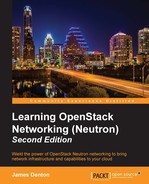The number of interfaces needed per host is dependent on the purpose of the cloud, the security and performance requirements of the organization, and the availability of hardware.
A single interface per server that results in a combined control and data plane is all that is needed for a fully operational OpenStack cloud. Many organizations choose to deploy their cloud this way, especially when port density is at a premium. Collapsed networking may also be used when the environment is simply used for testing, or network failure at the node level is a non-impacting event. It is my recommendation, however, that you split control and data traffic across multiple interfaces whenever possible.
For hosts using a single interface, all traffic to and from instances as well as internal OpenStack, SSH management, and API traffic traverse the same interface. This configuration can result in severe performance degradation, as a guest can create a denial of service attack against its host by consuming all available bandwidth.
The following diagram demonstrates the use of a single physical interface for all traffic when using the Open vSwitch driver. On the controller node, a single interface is connected to a bridge and handles external, guest, management, and API service traffic. On the compute node, a single interface handles guest and management traffic:

Figure 1.2
In the preceding diagram, all OpenStack service and management traffic traverses the same physical interface as guest traffic.
To reduce the likelihood of guest network bandwidth consumption impacting management traffic and to maintain a more robust security posture, segregation of traffic between multiple physical interfaces is recommended. At a minimum, two interfaces should be used: one that serves as a dedicated interface for management and API traffic and another that serves as a dedicated interface for external and guest traffic. Additional interfaces can be used to further segregate traffic. The following diagram demonstrates traffic split across two physical interfaces when using the Open vSwitch driver:

Figure 1.3
In the preceding diagram, a dedicated physical interface on the controller node handles OpenStack API and management traffic. Another interface is connected to a bridge that handles external and overlay traffic to and from Neutron routers and other network resources. On the compute node, a dedicated physical interface is used for management traffic and another for overlay traffic to and from instances.
In this book, the environment will be built using three interfaces: one for management and API traffic, one for external or VLAN tenant network traffic, and another for overlay network traffic:

Figure 1.4
In the preceding diagram, a dedicated interface on the controller node handles OpenStack API and management traffic. Another dedicated interface handles overlay traffic, and another is connected to a bridge that handles external traffic. On the compute node, a dedicated interface is used for management traffic, another dedicated interface handles overlay traffic, and another is connected to a bridge that handles VLAN traffic when VLAN tenant networks are in use.
NIC bonding offers users the ability to multiply available bandwidth by aggregating links. Two or more physical interfaces can be combined to create a single virtual interface, or bond, which can then be placed in a bridge or used as a regular interface. The technology used to accomplish this is known as IEEE 802.1ad Link Aggregation Control Protocol, or LACP. The physical switching infrastructure must be capable of supporting this type of bond. Legacy switching devices required the multiple links of a bond to be connected to the same switch. Modern devices support technology such as vPC and MLAG. They allow links of a bond to be connected to two switches, providing hardware redundancy between switches while allowing users the full bandwidth of the bond in normal operating conditions, with no changes to the server configuration necessary.
In addition to aggregating interfaces, bonding can also refer to the ability to create redundant links in an active/passive manner. Both links are simultaneously cabled to a switch or pair of switches, but only one interface is active at any given time. Both types of bonds can be created within the operating system when the appropriate kernel module is installed. Bonding can be configured in Open vSwitch if desired, but is outside the scope of OpenStack and this book.
Bonding interfaces can be an inexpensive way to provide hardware-level network redundancy to the cloud infrastructure. If you are interested in configuring NIC bonding on your hosts, refer to the Ubuntu bonding page at https://help.ubuntu.com/community/UbuntuBonding.
